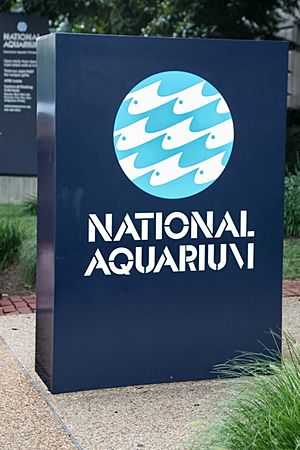National Aquarium in Washington, D.C facts for kids

Entry sign for the National Aquarium in Washington, DC, which was located on the lower level of the Department of Commerce Building
|
|
| Date opened | 1873 |
|---|---|
| Date closed | 2013 |
| Location | Herbert C. Hoover Building Washington D.C., United States |
| Coordinates | 38°53′37″N 77°01′58″W / 38.8936°N 77.0328°W |
| No. of species | 250 |
| Memberships | AZA |
The National Aquarium, Washington, D.C., was an aquarium in Washington D.C. It was located in the Herbert C. Hoover Building (owned by the General Services Administration), which is bounded by 14th Street NW on the east, 15th Street NW on the west, Pennsylvania Avenue NW on the north, and Constitution Avenue NW on the south.
Although the National Aquarium in Washington, D.C., was smaller than its Baltimore counterpart, with the experience taking around 45 minutes, it was the nation's first free and public aquarium. It closed on September 30, 2013, after 140 years.
Contents
History
The National Aquarium was established in 1873 in Woods Hole, Massachusetts under the auspices of the Federal Fish Commission by Commissioner Spencer Baird. It displayed 180 species of fish, reptiles, and other aquatic animals. In 1878, General Orville E. Babcock, the Superintendent of Public Buildings and Grounds in Washington, D.C. suggested a public aquarium in D.C. As a result, Spencer Baird's Fish Commission was given 20 acres of land. Because of this, the National Aquarium moved to the Washington Monument in 1878 and consisted of holding ponds known as "Babcock Lakes." During the 1880s, the aquarium moved again into a building called Central Station near the site of today's National Air and Space Museum so that it could better serve its main purpose of being an hatching station for the Fish Commission.
The Fish Commission was incorporated into the Department of Commerce in 1903 and renamed the Bureau of Fisheries. When the Commerce Department building was completed in 1932, the National Aquarium moved to the lower level of the building after Secretary of Commerce and Labor George B. Cortelyou called for "...a national aquarium of such size and architectural excellence that it will be a credit to the nation." The Bureau of Fisheries merged with the Division of Economic Ornithology and Mammalogy (later the Bureau of Biological Survey) in 1940 to form the Fish and Wildlife Service, an agency of the Department of the Interior. The National Aquarium remained based in the Department of Commerce building, where it remains today. It was the longest continuously operating aquarium in the United States.
In 2003, the National Aquarium Society Board of Directors signed an alliance agreement with the Board of Directors of the National Aquarium in Baltimore, enabling the two aquariums to work together to strengthen the animal collection and educational impact of the Aquarium.
Relationship with the National Aquarium in Baltimore
The National Aquarium in Baltimore is a separate aquarium in Baltimore, Maryland. Founded in 1981, it was originally distinct from the Washington aquarium. Both used the title "National Aquarium"; the National Aquarium in Washington, D.C., was older, while the National Aquarium in Baltimore is larger. Like its Washington counterpart, the National Aquarium in Baltimore is not managed or funded by the federal government, despite the official-sounding names. Neither is part of the Smithsonian Institution.
On September 4, 2003, the National Aquarium Society and the Board of Governors for the National Aquarium in Baltimore announced an alliance, in which the National Aquarium in Baltimore would operate the D.C. aquarium. A signing ceremony hosted by Secretary of Commerce Donald Evans was held at the Commerce Department building.
Collection
The National Aquarium, Washington, D.C., had a collection of over 1,500 specimens and 250 species. Animals in exhibits included longsnout seahorse, leopard sharks, longnose gar, bonytail chub, Giant Pacific Octopus, chambered nautilus, tiger salamander, eastern hellbender, American alligator, loggerhead sea turtle, red lionfish, and snakehead, as well as piranha, eel, and Japanese carp.
National Marine Sanctuaries and National Parks Gallery
The National Marine Sanctuaries and National Parks Gallery featured the animals and habitats preserved and protected by America's National Marine Sanctuaries Program. This gallery included exhibits for the Florida Everglades, Channel Islands National Marine Sanctuary, Cordell Bank National Marine Sanctuary, Fagatele Bay National Marine Sanctuary, Florida Keys National Marine Sanctuary, Flower Garden Banks National Marine Sanctuary, and Gray's Reef National Marine Sanctuary. Featured animals included:
- American alligator
- Anemones
- Chain catshark
- Chambered nautilus
- Giant Pacific octopus
- Guineafowl puffer
- Horn shark
- Leopard shark
- Longsnout seahorse
- Red lionfish
- Scarlet kingsnake
America's Freshwater Ecosystems Gallery
The gallery highlighted American rivers including the Rio Grande, the Potomac River, the Colorado River, and the Mississippi River. Featured animals included:
Amphibians Gallery
This gallery showcased salamanders, newts, frogs, and toads to display their amazing adaptations and biology. Featured animals included:
- Eastern newt
- Barking tree frog (Hyla gratiosa)
- Yellow-banded poison dart frog
- Blue-bellied poison frog
- Spotted salamander
- American toad
Amazon River Basin Gallery
The Amazon River basin supports some of the most diverse life on the planet. Featured animals included:
- Red-bellied piranha
- Silver arowana
- Blue poison dart frog
- Electric eel
- Emerald tree boa
Closure
The aquarium closed on September 30, 2013, after the Budget sequestration in 2013, having permanently lost its location due to the renovation of the Herbert C. Hoover Building.
It is considering ways of opening at another location in Washington, D.C., but, has no specific plans yet.

